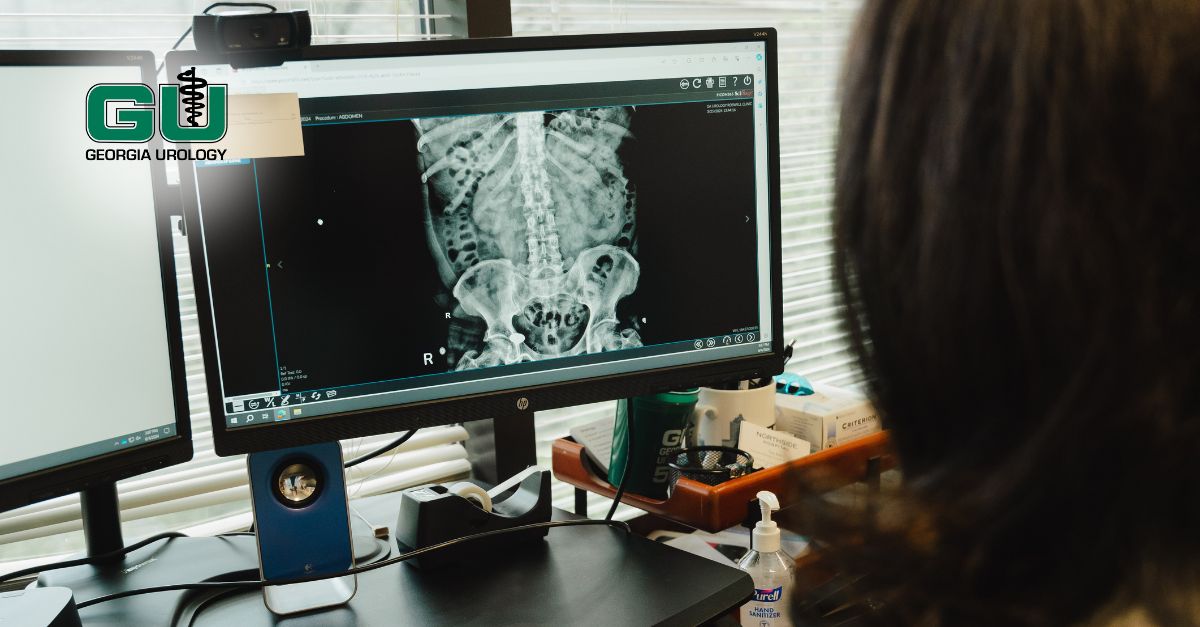Kidney Stone Truths and Myths This Stone Season
Living in the Atlanta area and the southeast United States generally has many benefits. However, a dubious distinction of our area revolves around why we are known as the “stone belt.” No, we’re not talking about mining stones or gems. Instead, it’s the fact that those who live in the southeast United States have a significantly higher risk of developing kidney stones versus patients in other parts of the United States. To understand why, we need to discuss more about kidney stones themselves.
Essentially, a kidney stone is composed of particles in the urine that merge to form a hard mass. As they collect and combine, they grow into an ever-larger stone. Not all kidney stones are symptomatic, but they become so when they begin to be passed but get lodged in the ureter or get so large within the kidney that they block the flow of urine and cause distension and inflammation. This leads to the telltale excruciating pain.
Knowing this, let’s discuss some myths about kidney stones and proper urinary tract function:
Cranberry juice can prevent kidney stones.
Unfortunately, this is a myth. While the hydration associated with drinking cranberry juice may reduce the risk of developing new kidney stones, no compound in the cranberry itself has a preventative effect, as far as we know. Some studies show that cranberry juice may even increase the risk of kidney stones. Cranberry juice may reduce the risk of urinary tract infections or UTIs, but this benefit does not necessarily extend to kidney stones.
I am less likely to develop stones if I eliminate calcium.
This is another myth and potentially dangerous advice to follow. Calcium benefits the bones and is especially important for middle-aged females at a higher risk of osteopenia and osteoporosis. No evidence definitively shows normal calcium intake directly correlates to stone formation. In fact, too little calcium consumption or too much can cause kidney stones.
Kidney stone procedures get you stone-free.
While it would be wonderful to have a range of procedures guaranteeing a stone-free post-procedure life, this isn’t the case. Each procedure has its unique benefits and risks and must be evaluated based on the composition of the stone and personal preference with the advice of your urologist. Shockwave therapy, or ESWL, is noninvasive and performed entirely outside the body. It can often effectively eliminate relatively smaller, softer stones within the kidney and ureters. However, remnant debris usually remains, and with that, there is a likelihood of stone formation in the future.
Ureteroscopy with laser lithotripsy is somewhat more invasive, though still minimally so. During this procedure, a ureteroscope is passed through the urethra and bladder up the ureters, and laser energy is used to break up stone formations into pieces small enough to pass. Because the urologist has direct visualization of the stone, it offers the patient a good chance of becoming stone-free. That said, a temporary stent is necessary, which can be mildly uncomfortable.
Finally, Percutaneous Nephrolithotomy, or PCNL, is a surgical kidney stone procedure that accesses challenging and particularly large stones within the kidney. While very effective, even allowing the urologist to physically remove the stone fragments, it has risks commensurate with its complexity. As such, we often leave this option as a final resort.
It is the size of the stone that causes the pain.
Many patients believe that a kidney stone’s size, shape, and jagged edges cause the pain, but this is untrue. The pain associated with the kidney stone is the blockage of urine, which results in a backup into the kidney, kidney enlargement, and severe pain. It is for this reason, therefore, that the patient should treat their kidney stones early and not ignore any pain or discomfort they may be experiencing,
And now some truths.
Proper hydration can help avoid kidney stones.
Even if you are prone to developing stones or have a family history, staying well hydrated allows the body to flush them out when they are smaller, thus passing them through the ureter with greater ease. Aim to drink 64 ounces of water or more each day. If you are prone to getting kidney stones, speak to your urologist about an even more aggressive hydration regimen.
Kidney stones can be treated effectively with several modalities.
Between non-invasive shockwave therapy, minimally invasive laser lithotripsy, and PCNL surgery, there is a kidney stone procedure for virtually everyone and every stone. Indeed, patients may qualify for multiple procedures, in which case they need to weigh the benefits and risks of each to understand more about what’s best for them. Fortunately, having a kidney stone intervention does not preclude a follow-up procedure, and often, the whole gamut of options is available no matter how you were previously treated.
For some, kidney stones are a fact of life.
It’s true; some of us are more likely to develop kidney stones than others. You may have your genes to thank for that, but taking the proper precautions, including hydrating properly, exercising frequently, and eating well, reduces the likelihood of developing a stone, no matter the cause.
Fever and stones don’t mix.
Kidney stones accompanied by fever or fever after a kidney procedure are problematic, and patients should seek immediate medical care, which may lead to a visit to the emergency room. Fortunately, for anyone in the greater Atlanta area, you have resources here at Georgia Urology. Our Kidney Stone hotline is answered 24/7 to quickly get patients an appointment to evaluate and ultimately treat their kidney stones.
If you’re experiencing any pain you think may be associated with kidney stones, we encourage you to contact our hotline and schedule a visit with one of our providers.



